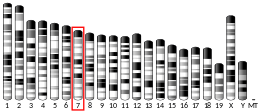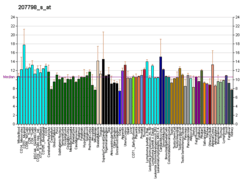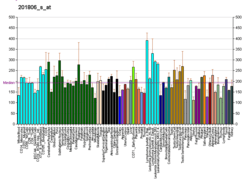ATXN2L
Ataxin-2-like protein was initially identified in 1996 and designated Ataxin-2 Related protein (A2RP) as the search for the gene causing SCA2 lead to the identification of 2 cDNA clones with high similarity to ATXN2 (Pulst et al, 1996). It was later renamed as ATXN2L. It is a protein that in humans is encoded by the ATXN2L gene.[5][6][7]
This gene encodes an ataxin type 2 related protein of unknown function. This protein is a member of the spinocerebellar ataxia (SCAs) family, which is associated with a complex group of neurodegenerative disorders. Several alternatively spliced transcripts encoding different isoforms have been found for this gene.[7]
Interactions
ATXN2L has been shown to interact with Myeloproliferative leukemia virus oncogene.[5]
gollark: Yes, ish.
gollark: The upvotes and whatnot have literally no effect on the investment revenue and whatnot.
gollark: I don't dislike everything, only [REDACTED]% of things.
gollark: I dislike it.
gollark: Mostly just because shares actually pay dividends and give you partial control of a company, giving them some actual use.
References
- GRCh38: Ensembl release 89: ENSG00000168488 - Ensembl, May 2017
- GRCm38: Ensembl release 89: ENSMUSG00000032637 - Ensembl, May 2017
- "Human PubMed Reference:". National Center for Biotechnology Information, U.S. National Library of Medicine.
- "Mouse PubMed Reference:". National Center for Biotechnology Information, U.S. National Library of Medicine.
- Meunier C, Bordereaux D, Porteu F, Gisselbrecht S, Chretien S, Courtois G (Mar 2002). "Cloning and characterization of a family of proteins associated with Mpl". J Biol Chem. 277 (11): 9139–47. doi:10.1074/jbc.M105970200. PMID 11784712.
- Figueroa KP, Pulst SM (Feb 2004). "Identification and expression of the gene for human ataxin-2-related protein on chromosome 16". Exp Neurol. 184 (2): 669–78. doi:10.1016/S0014-4886(03)00287-5. PMID 14769358.
- "Entrez Gene: ATXN2L ataxin 2-like".
- Pulst SM, Nechiporuk A, Nechiporuk T, et al. (1996). "Moderate expansion of a normally biallelic trinucleotide repeat in spinocerebellar ataxia type 2". Nat. Genet. 14 (3): 269–76. doi:10.1038/ng1196-269. PMID 8896555.
External links
- Human ATXN2L genome location and ATXN2L gene details page in the UCSC Genome Browser.
Further reading
- Andersson B, Wentland MA, Ricafrente JY, et al. (1996). "A "double adaptor" method for improved shotgun library construction". Anal. Biochem. 236 (1): 107–13. doi:10.1006/abio.1996.0138. PMID 8619474.
- Pulst SM, Nechiporuk A, Nechiporuk T, et al. (1996). "Moderate expansion of a normally biallelic trinucleotide repeat in spinocerebellar ataxia type 2". Nat. Genet. 14 (3): 269–76. doi:10.1038/ng1196-269. PMID 8896555.
- Yu W, Andersson B, Worley KC, et al. (1997). "Large-scale concatenation cDNA sequencing". Genome Res. 7 (4): 353–8. doi:10.1101/gr.7.4.353. PMC 139146. PMID 9110174.
- Strausberg RL, Feingold EA, Grouse LH, et al. (2003). "Generation and initial analysis of more than 15,000 full-length human and mouse cDNA sequences". Proc. Natl. Acad. Sci. U.S.A. 99 (26): 16899–903. Bibcode:2002PNAS...9916899M. doi:10.1073/pnas.242603899. PMC 139241. PMID 12477932.
- Brill LM, Salomon AR, Ficarro SB, et al. (2004). "Robust phosphoproteomic profiling of tyrosine phosphorylation sites from human T cells using immobilized metal affinity chromatography and tandem mass spectrometry". Anal. Chem. 76 (10): 2763–72. doi:10.1021/ac035352d. PMID 15144186.
- Beausoleil SA, Jedrychowski M, Schwartz D, et al. (2004). "Large-scale characterization of HeLa cell nuclear phosphoproteins". Proc. Natl. Acad. Sci. U.S.A. 101 (33): 12130–5. Bibcode:2004PNAS..10112130B. doi:10.1073/pnas.0404720101. PMC 514446. PMID 15302935.
- Gerhard DS, Wagner L, Feingold EA, et al. (2004). "The status, quality, and expansion of the NIH full-length cDNA project: the Mammalian Gene Collection (MGC)". Genome Res. 14 (10B): 2121–7. doi:10.1101/gr.2596504. PMC 528928. PMID 15489334.
- Ong SE, Mittler G, Mann M (2005). "Identifying and quantifying in vivo methylation sites by heavy methyl SILAC". Nat. Methods. 1 (2): 119–26. doi:10.1038/nmeth715. PMID 15782174.
- Lim J, Hao T, Shaw C, et al. (2006). "A protein-protein interaction network for human inherited ataxias and disorders of Purkinje cell degeneration". Cell. 125 (4): 801–14. doi:10.1016/j.cell.2006.03.032. PMID 16713569.
- Beausoleil SA, Villén J, Gerber SA, et al. (2006). "A probability-based approach for high-throughput protein phosphorylation analysis and site localization". Nat. Biotechnol. 24 (10): 1285–92. doi:10.1038/nbt1240. PMID 16964243.
- Olsen JV, Blagoev B, Gnad F, et al. (2006). "Global, in vivo, and site-specific phosphorylation dynamics in signaling networks". Cell. 127 (3): 635–48. doi:10.1016/j.cell.2006.09.026. PMID 17081983.
- Nonhoff U, Ralser M, Welzel F, et al. (2007). "Ataxin-2 interacts with the DEAD/H-box RNA helicase DDX6 and interferes with P-bodies and stress granules". Mol. Biol. Cell. 18 (4): 1385–96. doi:10.1091/mbc.E06-12-1120. PMC 1838996. PMID 17392519.
This article is issued from Wikipedia. The text is licensed under Creative Commons - Attribution - Sharealike. Additional terms may apply for the media files.





